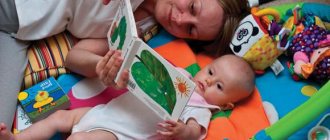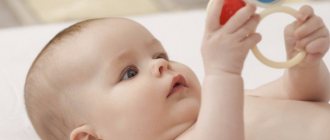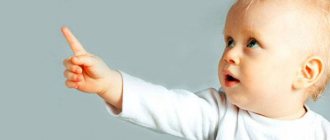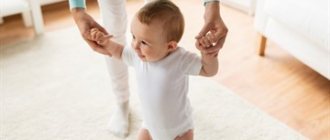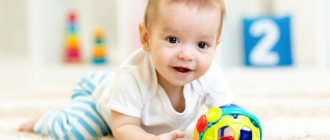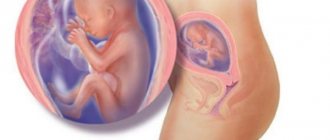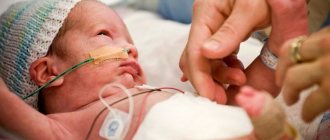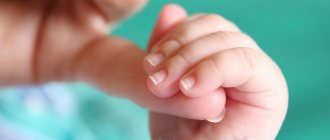Physiological development of the child
At this age, the baby experiences:
- Active growth.
- Weight gain.
- Reduced sleep duration.
- Increased activity of the salivary glands.
- Increased stomach capacity.
At 2 months, the child gains weight up to 800 g. His height increases by about 4 cm. The total duration of daytime and night sleep is usually 16-18 hours. During the day he can sleep 2 times for 2 hours and 4 times for half an hour. If a two-month-old baby sleeps 6-10 hours at night, this is considered normal.
A baby's sleep largely depends on how much time the mother spends with him and how often he holds him in her arms. If there is a lack of warmth and affection, he will not feel safe, and his sleep will be restless. He will wake up frequently to check if mom is nearby.
To ensure sound and healthy sleep, it is recommended to take frequent walks, sleep in the fresh air during the day, and play outdoor games.
What a baby should do at 2 months is to feed on his mother’s milk while suckling at the breast. The salivary glands are still poorly developed, secreting a small amount of saliva. The sucking movements become more active, but are still quite sluggish. During sucking, air can enter the stomach and cause regurgitation.
Therefore, after feeding, the baby must be held in an upright position.
At 2 months, stool can be up to 8 times a day if the baby is breastfed, but if bottle-fed, then up to 4 times. The color of the stool becomes golden yellow. In babies who are bottle-fed, it is lighter and denser, and the smell is stronger.
Physical development and skills of a two-month-old baby
At the end of the first month of life, the child’s weight increases by approximately 800 grams; this figure can fluctuate in different children within the range of 100-200 grams, both in one direction and the other. The baby grows by 2-3 centimeters, and the circumference of his chest becomes larger by 15-20 millimeters. A person does not grow with such intensity in any period of his life. To renew energy, which is intensively spent, the child’s sleep should be at least 18-20 hours a day. He still wakes up every 3-4 hours at night, but the intervals are getting longer. Conversely, during the day the baby is more active than he was in the previous month. Feeding should be provided at the baby’s first request; he should eat approximately a fifth of his own weight in milk per day. There is no need to give additional liquid, unless the apartment is too hot and dry.
See also:
Features of child development at 8 months Child development calendar
Features of child development at 1 year 3 months Child development calendar
Features of child development at 1 year and 9 months Child development calendar
A child's physical skills at two months are still weak, but significantly better than those of a newborn. He loses the chaotic movements of his arms and legs, and the nervous tremors of the first days of life. During this period, children learn to hold their heads. First, they twist it intensively while lying on their back. If you take the baby in your arms, he tries to turn his head in the direction that is comfortable for him. But you shouldn’t think that the baby is already holding his head confidently when taking him out of the crib or holding the baby in his arms in an upright position; you need to lightly hold it with your hand. From two months, children need to be placed on their tummy more often, then they will strengthen the muscles of the back and neck. You will see how the baby tries to raise his head and holds it for several seconds, arches his back, and rises on his arms. After this, the little one can lie down for a while and again make his attempts to get up.
A child at 2 months is already trying to move, is interested in his hands, and puts his fist in his mouth. Under no circumstances should you leave him alone in an unlimited space so that he does not turn over and fall off the sofa or table. If you hang a rattle over his stroller or crib, he can accidentally touch it with his arm or leg, getting a lot of pleasure from this and improving his motor skills. During this period, the limbs are already relaxed, their coordination is improving, the baby can even hold a toy in his hand for a short time. With pleasure he grabs his mother's finger and tries to pull it into his mouth. The child's movements can slow down or speed up, depending on his mood and reaction to surrounding sounds.
Let's briefly summarize everything that happens to the motor activity of children during the developmental period of 2 months:
- Can independently hold the head for a couple of seconds when on the handles in a vertical position
- Lying on his tummy, raises his chest and head, holds it for a few seconds
- Holds objects in hand for some time
- May relax arms and legs, which is associated with a decrease in hypertension characteristic of newborns
- He controls his muscles better, and involuntary movements are observed less and less often.
All of these skills will be improved over the coming months. During this period, you should not overload the child with physical games or exercises. Let your muscles strengthen naturally. Believe me, in less than two dozen days the child will develop new skills and become much stronger.
Motor skills and movements of the child
At the age of two months, a child’s activity increases and his mobility increases. The baby's movements are no longer sharp, but are now slow. His work continues to master his body. A two-month-old baby already rests his feet on a hard surface and holds in this position for several seconds.
The head still needs to be supported.
The baby learns to raise and lower his arms and roll over from one side to the other. Some two-month-old babies attempt to crawl if they are lying on their stomach. At the same time, they put their knees forward in turn.
A baby of this age is characterized by sucking not only during eating. Between feedings, he can suck on anything that goes into his mouth: a pacifier, his hand, a diaper or a rattle. He feels that these objects do not satisfy his hunger and urgently spits them out, starting to scream.
Hand movements
A two-month-old baby exhibits some changes in movements:
- He begins to clench his fingers into fists and unclench them.
- If you place a rattle in his hand, he will enthusiastically watch and examine it.
- A 2 month old baby is interested in putting everything he comes across into his mouth. As a rule, parents begin to worry about this. But you shouldn’t worry, because this is how children learn about the world.
- Grabbing mom's clothes or hair becomes a favorite activity of a two-month-old baby. But he still cannot understand that she needs to be released.
- He certainly now wants to grab the object that attracted his attention. If an object of interest falls into his hands, he will shake it and try to bring it to his mouth. If it is a rattle, it will seem to him as if it is an extension of his hand and will begin to suck. If the rattle falls out of his hand, it will not cause any emotions in him.
In the video you can see how a normally developing 2-month-old baby moves his arms:
At 2 months, the movements of the arms and legs cease to be chaotic. Coordination improves and tone disappears.
What should a baby be able to do in the second month?
At two months, the baby can independently lift and hold his head in an upright position for a few seconds.
Hold the toy in your hands and swing it, holding it firmly with your palm.
Starting from the second month of life, the baby begins to build the first cause-and-effect relationships. That is, he begins to understand that if he cries or raises a voice, then they will approach him.
The baby smiles, calls, fixes his gaze and follows moving objects.
In healthy babies, by two months of life, muscle tone returns to normal. The child stops clenching his fingers into fists so intensely, and movements become more free. The child can lie in a calm, relaxed state. At the same time, he becomes interested in surrounding objects, he can grab a diaper, a rattle, care items, everything that comes to his hand.
A baby sleeps about 18 hours a day. Night sleep begins to be established, lasting 8-10 hours with breaks for feeding.
Can a 2 month old baby hold his head up?
Along with the improvement in the ability to move the arms, the neck muscles of a two-month-old baby become stronger. He begins to control his head movements. If he is placed on his stomach, he can lift it up. When the baby is held vertically, he is able to hold his head straight for a few seconds.
The most developed babies can even prop themselves up on their arms while lying on their stomach.
What a baby should be able to do at 2 months is try to hold his head while lying on his stomach.
The head is still larger than the rest of the body and heavy, so it still needs to be supported. If this is not done, a sharp deviation of the head can damage the cervical vertebrae. If the baby has not learned to hold his head up at 2 months, this is not a reason to worry. Everything is individual.
Baby gains new motor skills
He already confidently raises his head and can hold it for 10–20 seconds; when lying on his stomach, the child, in addition to his head, also lifts his chest and can remain like this for some not very long time. The frog position, characteristic of the first weeks, begins to transform into a human one: the child’s arms and legs are more relaxed, he stretches them more and more to the sides. If one of the elders supports the baby in a sitting position, he may shake his head, and involuntary flinching and twitching of muscles occurs less and less in the child.
Any bright spot, a rattle that makes melodious sounds are the most curious objects for a baby at this age.
He grabs the toy tightly and can hold it for a while. And when the child’s hands are not occupied with a toy, his fists are partially open. Sometimes the baby flails his arms through the air with all his might - and this is quite normal for children of this age.
Hearing development
When the baby is 2 months old, it is time to check the quality of his hearing by slapping his hand on the surface on which he is lying. In addition, you can use a bell by ringing them from behind or on the side, as well as a rattle. The baby will turn its head in search of the source of the sound, blink or frown.
If mom or dad starts talking to him, he will listen, turn his head and look for where the voices are coming from. In any case, the reaction must manifest itself. If it is not there, you need to consult a doctor and tell him about the problem.
What a 2-month-old child should be able to do regarding hearing is:
- show response to sounds;
- recognize mother's voice among others;
- pick up quieter noises;
- flinch from sharp sounds;
- turn your head in search of the source of the sound.
The second month of a child’s life – emotional development
At the end of the 2nd month, the baby's first smile , usually intended for one of the parents. He smiles in response to something he particularly likes or in response to another person's smile. Soon the baby will understand that with his behavior he can cause a reaction in the person he is observing. Towards the end of the second month, loud laughter sometimes appears, accompanied by fast, joyful movements of the arms and legs. During this period, the child loves society, the company of other children, and strangers do not yet cause fear in him.
At the 5th week of life, the baby may also experience his first tears while crying. This indicates the development of complex reactions of the nervous system. The beginning of activity of the lacrimal glands at the same time enriches the child's life, giving him another, new way of expressing emotions.
Along with the development of the nervous system, as the newborn's sensory development progresses, he begins to actively come into contact with the outside world. A certain range of emotional reactions begins to take shape - both positive and negative. The baby becomes animated, for example, in preparation for feeding. At two months old, a baby begins to respond with facial expressions to facial expressions and the tone of a human voice. At this time, you may notice that the child habitually reacts to some routine actions - joyfully waving his arms, making certain movements.
The baby becomes curious, he likes when his parents carry him in their arms and he can look around. He reacts vividly to the sight of his parents. No one can calm him down like mom or dad: the baby stops crying when you approach the crib. He looks at faces with curiosity, loves to listen when you speak in a calm, melodic voice, and babbles something. And when you repeat his “aha”, he may laugh joyfully.
Tips for parents:
- Play with your baby when he is lying in the crib, hang colorful toys above it.
- Give yourself and your baby ordinary moments of life: you can lie down and put him on your stomach so that he feels your warmth, hears your voice, your heartbeat.
- Communicate with the baby, sing lullabies, pick him up, read simple books out loud, try to talk to a two-month-old baby, repeating the sounds he makes.
Baby's vision at 2 months
A two-month-old baby can focus his gaze on something for up to half a minute. You can place bright objects near it. The first color he sees is red. As a result, it is advisable for the first toys to be red. At 2 months, the baby tries to track the movement of objects.
To develop this skill, you can hang a mobile above his crib.
At this age, the baby recognizes the faces of mom and dad, as well as loved ones. His eye movements become smooth. The visual system already perceives the volume of objects. To develop vision, it is necessary to play with the baby. One of the game options is the most popular.
This is when an object, such as a rattle, is moved from one side to the other. The distance from the baby’s eyes to the object should be 30 cm. Movements should be made slowly so that the child has time to follow the movement of the object. You can also zoom in and out.
Neuropsychic development of a child in the second month
To assess the neuropsychic development of a child, the doctor evaluates several main criteria: motor skills, statics, conditioned reflex activity, speech and higher nervous activity.
Motor skills (or movement) are the purposeful, manipulative activities of a child. By two months, the movements of the eye muscles become more coordinated, thanks to which the child fixes his gaze well on bright objects. Turning the head behind the toy indicates the development of the neck muscles.
Statics is the fixation and holding of certain parts of the body in the required position. The first sign of static in a baby is holding his head. This skill appears at 2-3 months of life and is further improved.
Conditioned reflex activity is the baby’s adequate reaction to various irritating environmental factors and his own needs. The main reflex in a two-month-old baby, like in a newborn, is still the food reflex (dominant). But, in the second month, the child begins to smile and feel excited about the appearance of his mother. Signs of conditioned reflex activity also include auditory and visual concentration. At two months, the baby should blink in response to a loud, sharp sound. Also, at this age, the baby should already be able to follow the movement of an object well.
A child of the first year of life is characterized by sensory speech - the child’s understanding of individual words that sound from the outside. The first signs of speech appear in the baby at 4-6 weeks, when he begins to howl.
Higher nervous activity - this criterion develops as the nervous system develops, as well as on the basis of the formation of all previous criteria, the upbringing and development of the child. The final conclusion about the state of higher nervous activity can only be made at 5-6 years of age.
After the second month of life, the newborn’s reflexes begin to gradually fade away.
Intellectual development
While awake, the child actively explores the world. He is interested in everything that comes into his field of vision. He looks at objects, his mother’s face, recognizes her voice, and tracks the movement of the rattle. Unfamiliar sounds make him wary.
He listens to them and trains himself to make connections between what he saw and heard. First he hears a sound and freezes. So he listens to him. Then the baby turns his head, looking for what made the sound. There is an active development of cause-and-effect relationships.
Now the child rattles the rattle for a reason. He begins to realize that there is a relationship between movement and sound. That is, in order for the rattle to rattle, it must be shaken. A mother is the most important person for a baby. He believes that only she can calm and protect him. For now he walks calmly into the arms of strangers, but when he sees his mother he already smiles.
The baby already realizes that by crying, he will attract the attention of his parents and his needs will be satisfied.
Forming a Buzz
What a 2-month-old child should be able to do regarding speech is to replace drawn-out monotonous sounds with a variety of vowel sounds. He starts to walk. This is especially noticeable at the moment when he is in a positive mood and joyful excitement. Having heard himself and his new sounds, the baby freezes and becomes aware of them.
It’s still unusual for him to hear this from himself. Thanks to such an exciting activity, the child can lie quietly in his crib alone. By the end of the second month, the baby adds some consonants to the vowels and pronounces whole syllables.
He can talk to his parents and respond to their suggestions by humming.
Emotions and consciousness
A distinctive feature of a child at two months of age is a revival complex. This is a child's reaction to a person he knows and loves, such as a grandparent or parent. It happens something like this: the baby lies in the crib; his mother approaches him, bends over him and speaks affectionately; The child at this time reacts to its appearance with chaotic movements of the arms and legs.
So he rejoices at the appearance of his loved one.
What a 2 month old baby should be able to do is smile. A smile indicates that the baby is developing without any problems. Thus, he establishes contact with adults and reacts to their speech or actions.
At this age, the child consciously reacts to what irritates him. Be it sounds or uncomfortable clothes, hunger or cold. The degree of discomfort affects the strength of the cry and its modality. Usually the baby turns red when crying and takes a long break in breathing during it.
Height and weight
A little later you will find out what kind of development an infant (2 months) has. The height and weight of the baby are individual indicators. These data depend on what parameters the baby was born with. In most cases, the birth of a child occurs between the 37th and 42nd weeks of pregnancy. At the same time, weight and height are in the range of 2.5-4.5 kilograms and 48-60 centimeters. However, there are also situations when a baby is born premature. In this case, its weight can be from 500 grams, and its height will be at least 30 centimeters.
Upon reaching the age of two months, the child’s weight should increase by an average of 1.6-2.5 kilograms. The baby must gain up to 8 centimeters in height. The average body weight of a baby at 2 months is 5 kilograms. At the same time, boys can weigh a little more, and girls - less. The height of such babies will be about 60 centimeters. It is worth noting that each pediatrician has standards according to which he gives the child a rating on a five-point scale. All data is entered into an individual card.
Features of a child's daily routine
The daily routine of a two-month-old baby includes sleep, feeding, wakefulness and hygiene procedures. At this age, children usually sleep up to 20 hours a day , waking up to satisfy their hunger. At night they can wake up twice to suckle at their mother's breast, and during the day 7 or 8 times. The interval between feedings during the day is usually 2-3 hours.
All figures are approximate, as all children are individual.
Sometimes a two-month-old baby may confuse day and night. In this case, it is necessary to organize the correct daily routine. For example, get up and wake up the child at 6 am, feed and wash. To go to bed at night, you also need to choose a specific time and stick to it.
Gradually, the child will get used to the new rules and his body will adjust to the desired regime.
The daily routine of a two-month-old bottle-fed baby is slightly different from a breast-fed baby. The reason for this is the long absorption of the mixture. Therefore, the break between feedings in this case is 4 hours.
The immune system
How does a small child (2.5 months) work? The baby's development and psychology completely depend on his mother, as does his protection. The baby does not yet have immunity as such. Most children do not get sick in the first months of life, as their parents carefully protect them. It is worth saying that during this period the child receives the antibodies he needs from food. This is why doctors so strongly advise feeding him breast milk.
This food contains all the vitamins, elements and immunoglobulins. If you are forced to switch to artificial feeding, then you need to choose the right, suitable mixture. This will allow the baby to avoid lack of nutrients.
Activities for the development of a child at 2 months
At two months of age, it is necessary to organize play activities for the child so that the following qualities develop:
- motor skills;
- hearing;
- tactile sensations;
- coordination of movements;
- vision.
To develop motor skills, the mother should learn several nursery rhymes and tell them to the baby, bending and unbending his fingers or clapping his hands.
You can do the following exercises:
- The mother stretches the baby's fingers in order. They should be pulled lightly and gently, without jerking sharply.
- Move the child's fingers in a circle, first in one direction, then in the other.
- Move your thumb in a circle over the baby's palm.
Games using rattles develop hearing and coordination. An adult takes a rattle in his hand and begins to shake it, moving it in different directions at different speeds. You can hum the song at the same time. Tactile sensitivity should be developed by examining various objects by touch.
Fabrics made of corduroy, wool, silk or satin are suitable for this.
They need to be placed in the baby's hands so that he touches and strokes them. Objects of various textures: soft or hard, smooth or rough, smooth or ribbed, and massage also helps to develop sensitivity in the fingers.
You can also do the following exercises: blow on your stomach or back, stroke your arms and legs, or other parts of the body, naming them. While breastfeeding, it is convenient to give him a massage. To do this, you need to stroke his palms and each finger.
After this, you can knead them, bend and unbend them and make circular movements with them. To develop visual perception, you can put bright socks on your child. Mom can put a bright doll on her hand and move it around, only smoothly, so that the baby has time to follow it.
What can a premature baby do at 2 months?
What a premature baby should be able to do at 2 months is a question that worries mothers even more who gave birth to a baby prematurely. At first, such children lag behind the norms of full-term children. They need more attention. A mother needs to create a favorable atmosphere for her child, surround her with tenderness and care.
In such comfortable conditions, a premature baby will quickly catch up with the level of development of a baby of the same age who was born on time.
By the end of the second month, the premature baby begins to rapidly gain weight and grow in length. He is characterized by fatigue. He needs increased nutrition. In general, premature babies do not remain underdeveloped; they grow up to be healthy and normal children. They learn the same skills, just slower.
This is explained by the fact that the baby’s organs and systems are not fully developed.
The following deviations from the norm are identified in premature babies at 2 months:
- decreased strength of the swallowing and grasping reflex;
- rapid hypothermia or overheating;
- slow digestion of food;
- immature visual system (mostly the baby lies with his eyes closed);
- physiological jaundice;
- weakened immunity.
A two-month-old baby, like all babies, causes excitement and worry in parents. There is no need to be nervous and afraid. If something makes you worry, you should consult with your pediatrician and tell him all the points that cause anxiety.
The main thing that a baby needs at the age of two months is the care, affection and attention of his parents. As well as gentle touches, a simple massage and the usual stay in the arms of your beloved parents. This way he feels safe and becomes calmer.
What a baby should be able to do at 2 months is a question that pushes moms and dads to study the norms of child development. This will help them get through the difficult period of infancy more comfortably. Children are unique and each one develops at a different pace, so don't worry if someone else's child develops faster.
Article design: E. Chaikina
Psychology of a child at two months of age
The psychological development of the baby is very closely related to the neurological status. That is why you need to take care of the correct development of your child’s skills. It is worth noting that children who have a daily routine are less likely to get sick. They are calmer and more balanced. That's why it's so important to properly organize your baby's life. Try to feed him at the same time, the bedtime ritual should always be performed. Remember that during the first year of life, your baby's schedule may change several times. Adapt to it, but don't forget that everything depends on you.
When your child is awake, talk to him constantly. Don't forget that he hears you and understands your intonation. Talk about your actions. During a walk, if the baby is not sleeping, show him different objects. This will help the baby develop faster.
Many mothers complain that they do not have time to do household chores. Ask your husband or new grandmothers for help. Believe me, now you are very important to the child. In just a few months, the baby will become more independent. Don't miss this moment of development. Correctly shape your child's psychology.
